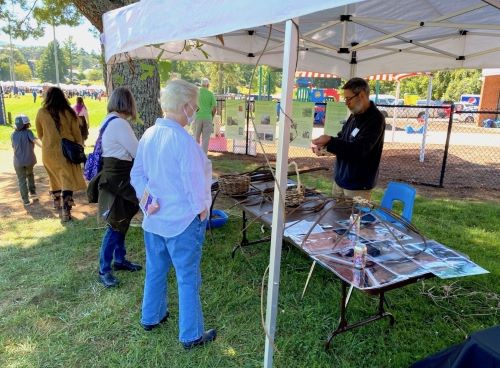The story of kudzu is one of many trials and tribulations experienced by early farmers. Now, many years later, their descendants have learned of a way to turn kudzu into unique decorations made for any home.
Kudzu has been in the United States since the late 19th century. It first was seen in a display at the Japanese Exhibition of the Philadelphia Centennial Exposition in 1876. It was later displayed in the New Orleans Exposition in 1883.
The Japanese and New Orleans expositions showed just how useful kudzu was. It became so popular with the viewers that kudzu seeds were being imported and sold in the United States. They were being used as an ornamental vine to shade porches and courtyards of southern homes.
Kudzu has roots that grip soil firmly, so it was used to help stabilize the land in the South. Southern farmland had erosion problems that were caused by poor farming practices prior.
There were about 85 million kudzu plants given to southern landowners all over the South by the Soil Erosion Service to help with the erosion problem.
In the early 1950s, kudzu became an invasive species when it spread rapidly throughout the South due to a long growing season, warm climate, plentiful rainfall and lack of disease and insect enemies allowed them to grow. It is now listed as a harmful weed in 13 states.
“Kudzu is a nitrogen-fixing plant, in the pod family. It has a little bump on the root that contains bacteria that function in nitrogen fixation,” said Dr. Breverly Collins, Professor of Biology at Western Carolina University. Since the dirt is rich in nitrogen that changes the soil fertility, which helps plants grow faster.
Kudzu can grow at a rate of one foot per day. Southerners have named it “mile-a-minute” because of that.
“It grows very aggressively, can literally cover over trees and you if you were standing still long enough, but it can cover buildings and trees in the forest,” said Collins.
When kudzu grows up on trees, it creates a very dense canopy that makes it dark underneath. This causes trees and shrubs under it not to germinate.
With kudzu being such an invasive species that can grow up fast, people wonder if it can actually be stopped.
“It is actually possible to get rid of kudzu but it requires quite a bit of work. You have to essentially cut it back and cut it back, especially over the winter or before it gets started every spring,” Collins explained.
Instead of burning the kudzu, people decided to use it. They created a new craft called Kudzu crafts. It can range from baskets to ropes and whatever the imagination creates.
With the introduction of kudzu to the Western Carolina area in the 1930s, the Cherokee people in the area started to use it for basket weaving and ropes.

One kudzu craft artist is Jeffrey Gottlieb. Gottlieb is from Long Island, NY where he gained his knowledge of kudzu crafts from using the kudzu found there.
“I got interested in this throughout my many years of study in Primitive Living Skills and Wilderness Survival,” Gottlieb said. “I have studied rope making and plant fibers, and it was natural to examine kudzu when I moved here 10 years ago.”
Gottlieb showed his skills during this year at Mountain Heritage Day as a demonstrator for traditional crafts.
Those are just a few things Gottlieb teaches people on a regular basis. He teaches primitive living skills, traditional skills of the pioneer homestead and basketry. More on his classes can be found on Gottlieb’s website.
More information on the history and impacts kudzu has on the South can be found at Extension by Alabama A&M and Auburn Universities.


